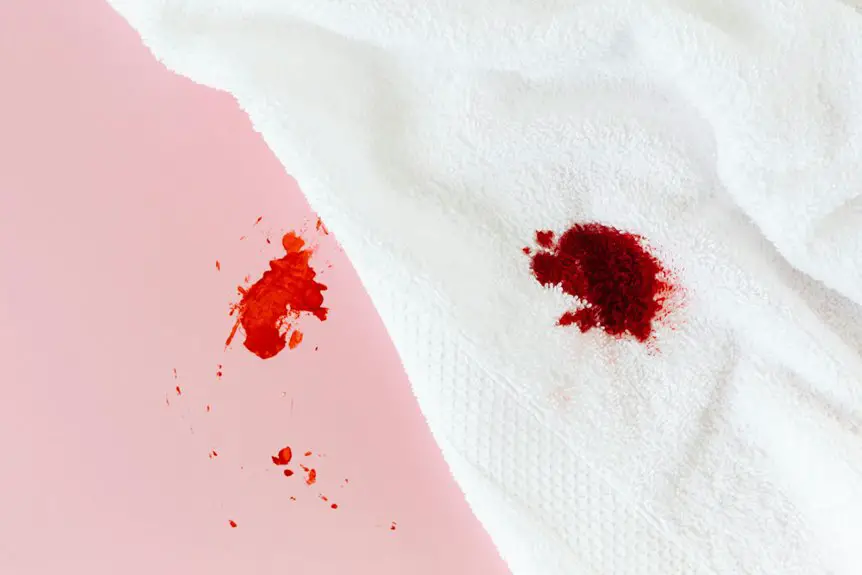To freshen up delicate fabrics without causing damage, start by checking care labels and testing any methods on a small area first. Hand wash using a gentle detergent and cold water to minimize agitation. Consider a vinegar and water solution to eliminate odors naturally. Air drying is preferable, keeping items out of direct sunlight. Proper storage in breathable bags also helps maintain freshness. Learn more about specific techniques for caring for your delicate items.
Table of Contents
Key Takeaways
- Use a vinegar and water mixture to effectively eliminate odors without harming delicate fibers.
- Sprinkle baking soda on the fabric to absorb and neutralize unpleasant smells safely.
- Hand wash delicate items with cold water and a gentle detergent to protect their integrity.
- Air dry fabrics in a shaded area to prevent sun damage and maintain their shape.
- Store clean fabrics in breathable cotton bags and avoid direct sunlight to prevent deterioration.
Understanding Delicate Fabrics
When you handle delicate fabrics, understanding their unique qualities is essential. These materials, like silk, lace, and chiffon, require special care to maintain their beauty. You’ll want to know their fiber content, as this affects how they react to cleaning agents and water. Always check care labels for specific instructions, as they provide invaluable information.
It’s also vital to recognize how sensitive these fabrics are to temperature changes, moisture, and friction. For instance, excessive heat can cause shrinkage or damage, while improper washing techniques can lead to distortion.
Common Causes of Odors in Delicate Materials
While you might think delicate fabrics are immune to odors, several common causes can lead to unpleasant smells.
First, body oils and sweat can seep into the fibers, especially if you wear the garment multiple times without washing.
Body oils and sweat can penetrate delicate fabrics, especially when worn repeatedly without washing.
Second, food spills or lingering cooking odors can cling to lightweight materials, contributing to an unpleasant scent.
Third, mold and mildew can develop if you store items in damp conditions or fail to dry them properly after washing.
Finally, dust and pet dander can accumulate over time, creating a musty odor.
To keep your delicate fabrics fresh, it’s essential to identify these sources of odor and address them promptly.
Importance of Testing Fabric Care Methods
When caring for delicate fabrics, knowing the specific type you’re dealing with is essential.
You should always start with a test patch to see how the fabric reacts to any cleaning method, as care recommendations can vary widely.
This simple step can save you from costly mistakes and help keep your items looking their best.
Fabric Type Identification
Identifying fabric types is vital for effective care and maintenance, especially when dealing with delicate materials. Different fabrics have unique properties that affect how they should be cleaned, stored, and handled.
For instance, silk needs gentle care, while cotton can withstand more robust methods. Start by looking at labels—these often provide significant information about the fiber content.
If a label’s missing, perform a simple burn test. Each fabric reacts differently to heat, helping you identify its type. Knowing whether you’re dealing with natural fibers like wool or synthetic materials like polyester guides your care decisions.
This understanding prevents damage and guarantees your delicate fabrics remain in the best possible condition for years to come.
Test Patch Method
Knowing the type of fabric you’re working with sets the stage for proper care, but testing your cleaning methods can make all the difference in preserving delicate materials.
Before applying any cleaning solution, choose a hidden area of the fabric for your test patch. This could be the inside seam or a less visible spot.
Apply a small amount of the cleaner and wait for a few minutes to see how the fabric reacts. Look for any discoloration, fading, or texture changes.
If all looks good, you can proceed with confidence. If not, try a different method or solution.
This simple test can save you from irreversible damage, ensuring your delicate fabrics stay fresh and beautiful for longer.
Care Recommendations Variability
Although you might’ve a go-to cleaning method for your delicate fabrics, it’s vital to recognize that care recommendations can vary considerably based on the specific material.
Different fabrics, like silk, lace, or chiffon, each require unique care techniques to maintain their integrity and appearance. Some materials may react poorly to certain detergents or cleaning methods, leading to damage or discoloration.
That’s why it’s important to test a small, inconspicuous area before applying any cleaning method broadly. By doing this, you’ll guarantee that your choice won’t compromise the fabric’s quality.
Always consult the care label for guidance and stay informed about the best practices for each type of fabric you own. Protecting your investment starts with proper care.
Gentle Washing Techniques for Delicate Fabrics
When it comes to washing delicate fabrics, hand washing is often your safest bet, allowing you to control the process with care.
However, if you choose to use a machine, there are important precautions you should take to protect your garments.
Let’s explore the best techniques to keep your delicate items looking fresh and beautiful.
Hand Washing Benefits
Hand washing delicate fabrics can greatly extend their lifespan and maintain their beauty, especially since commercial washing machines often use harsh cycles.
By choosing to hand wash, you control the water temperature and detergent concentration, which helps protect fibers from damage. You can gently agitate the fabric, allowing dirt and stains to lift without the risk of stretching or snagging.
Plus, hand washing lets you focus on intricate details, like lace or embroidery, ensuring they remain intact. This method also reduces the likelihood of color fading, keeping your garments vibrant.
Ultimately, hand washing is a mindful choice that nurtures your delicate items, preserving their quality and charm for years to come.
Machine Washing Precautions
While machine washing can be convenient, taking precautions is essential to protect your delicate fabrics.
To guarantee your items stay in great condition, follow these gentle washing techniques:
- Use a mesh laundry bag: This keeps delicate pieces safe from snags and tangles.
- Select a gentle cycle: Opt for the delicate or hand wash cycle to minimize agitation.
- Choose cold water: Washing in cold water helps prevent shrinking and fading.
Using Vinegar and Water for Freshening
A simple solution for freshening delicate fabrics involves mixing equal parts vinegar and water. This gentle method helps eliminate odors without harming the fibers. Start by testing the mixture on a small, inconspicuous area to verify it doesn’t affect the color or texture. Once you’ve confirmed it’s safe, lightly spray the solution on the fabric and allow it to air dry.
Here’s a quick reference table for your convenience:
| Step | Action | Tips |
|---|---|---|
| 1 | Mix vinegar and water | Use a spray bottle |
| 2 | Test on a small area | Wait 10 minutes |
| 3 | Spray the fabric lightly | Avoid soaking the fabric |
| 4 | Let it air dry | Do not use heat sources |
This method refreshes your fabrics effortlessly!
The Role of Baking Soda in Odor Elimination
Baking soda serves as a powerful ally in eliminating odors from delicate fabrics, especially when you’re looking for a gentle yet effective approach.
Its unique properties neutralize unpleasant smells without damaging your cherished items. Here’s how you can harness its benefits:
- Absorbs Odors: Baking soda captures and neutralizes odors, leaving your fabrics fresh.
- Gentle on Fabrics: Unlike harsher chemicals, it’s safe for most delicate materials, ensuring your clothes remain intact.
- Easy to Use: Simply sprinkle a small amount on the fabric, let it sit for a few hours, and then shake or brush it off.
Air Drying vs. Machine Drying: What to Choose
How do you decide between air drying and machine drying your delicate fabrics?
It really comes down to the fabric type and your time constraints. Air drying is gentler and helps preserve the shape and integrity of delicate materials like silk and lace. If you’ve got the time, hang your items in a shaded area to avoid sun damage.
On the other hand, if you’re in a hurry, a machine dryer on a low-heat setting can work, but it’s riskier. Always check the care label first, and consider using a mesh laundry bag to protect your garments.
Ultimately, when in doubt, air drying is the safest bet for maintaining the quality of your delicate fabrics.
The Benefits of Professional Cleaning Services
When it comes to caring for delicate fabrics, professional cleaning services offer you expertise that can make a big difference.
With advanced cleaning techniques tailored for these materials, you can trust that your items are in good hands.
Plus, you save time and money by letting the professionals handle the hard work for you.
Expertise in Delicate Fabrics
While you might think you can handle cleaning delicate fabrics on your own, professional services offer expertise that guarantees your prized items remain in pristine condition.
Trained specialists know how to treat various materials without causing damage, ensuring your fabrics last longer and look their best.
Here are a few benefits of relying on professional cleaning services:
- Tailored Techniques: Experts use methods specifically designed for each fabric type, avoiding common mistakes you might make.
- Stain Removal: Professionals have access to advanced products and techniques that can effectively tackle stubborn stains without harm.
- Time-Saving: Letting the experts handle the cleaning saves you valuable time and reduces the stress of doing it yourself.
Trusting professionals can make all the difference in preserving your delicate fabrics.
Advanced Cleaning Techniques
Utilizing advanced cleaning techniques, professional services guarantee your delicate fabrics receive the best care possible. They employ specialized methods tailored to each fabric type, ensuring your items are cleaned without risk of damage.
Techniques like gentle steam cleaning and eco-friendly solvents effectively lift dirt while preserving the integrity of fibers.
Moreover, professionals understand the unique requirements of silk, lace, and other delicate materials, applying their expertise to avoid common pitfalls.
With their knowledge of colorfastness and shrinkage, you can trust them to maintain your fabrics’ vibrant hues and sizes.
Time and Cost Efficiency
Considering the busy pace of modern life, you’ll find that professional cleaning services not only save you time but also provide excellent value for your investment.
By hiring experts, you can focus on what truly matters while they handle your delicate fabrics with care.
Here are a few key benefits:
- Expertise: Professionals know the best techniques for cleaning delicate materials without causing damage.
- Convenience: You won’t have to worry about time-consuming cleaning processes or the hassle of dealing with stains yourself.
- Cost-Effective: Investing in professional services can prevent costly mistakes, like fabric damage, ultimately saving you money in the long run.
In short, choosing professional cleaning services gives you peace of mind and enhances the longevity of your delicate fabrics.
Storing Delicate Fabrics Properly
When you’re storing delicate fabrics, it’s essential to handle them with care to prevent damage. Start by cleaning the fabric according to its care instructions.
Once clean, fold it gently to avoid creases. Instead of using plastic, opt for breathable cotton storage bags or acid-free tissue paper to protect the fibers.
Avoid hanging delicate items, as this can stretch them out of shape. Make certain the storage area is cool, dry, and away from direct sunlight, which can fade colors.
If possible, keep them in a drawer or on a shelf to minimize exposure to dust. Regularly check on your stored fabrics to verify they’re maintained in good condition, ready for use when you need them.
Preventive Measures to Keep Fabrics Fresh
To keep your delicate fabrics fresh, you should adopt a few simple preventive measures that can make a significant difference.
Regular care is key, and a few adjustments to your routine can help maintain their quality.
- Avoid direct sunlight: Store your items in a cool, dark place to prevent fading and deterioration.
- Use breathable storage bags: Opt for cotton or linen bags instead of plastic, allowing air to circulate and reducing moisture buildup.
- Rotate usage: Don’t wear the same delicate items repeatedly; give them a break to prolong their lifespan.
Frequently Asked Questions
Can I Use Essential Oils to Freshen Delicate Fabrics?
You can use essential oils to freshen delicate fabrics, but be careful. You don’t want to release a fragrant tornado that overwhelms your senses or damages your precious items. Always dilute them first!
How Often Should I Freshen My Delicate Fabrics?
You should freshen your delicate fabrics every few weeks, depending on usage. If they’re stored or rarely worn, doing it monthly is fine. Always spot-test your method to guarantee you don’t cause any damage.
Is It Safe to Steam Delicate Fabrics for Odor Removal?
Steaming delicate fabrics can safely remove odors, but you’ve gotta be cautious. Always test a small area first. If the fabric reacts well, then go ahead and steam it to freshen things up!
What Should I Do if My Delicate Fabric Shrinks?
If your delicate fabric shrinks, don’t panic. Gently stretch it while damp, then lay it flat to dry. Avoid heat sources, and consider using a fabric conditioner to help restore its original shape and softness.
Are There Specific Detergents for Delicate Fabrics?
Indeed, you’ll find specific detergents tailored for delicate fabrics, designed to clean without causing harm. Always opt for gentle, sulfate-free options to maintain their softness and longevity; your garments will thank you for it!
- Nonwoven Fabrics in the Medical Industry: An Overview - July 11, 2025
- Can You Iron Nonwoven Fabric? A Safety Guide - July 11, 2025
- Exploring the Strength and Durability of Nonwoven Fabrics - July 11, 2025







